Affiliate links on Android Authority may earn us a commission. Learn more.
Samsung Galaxy S4 review
Published onApril 21, 2013
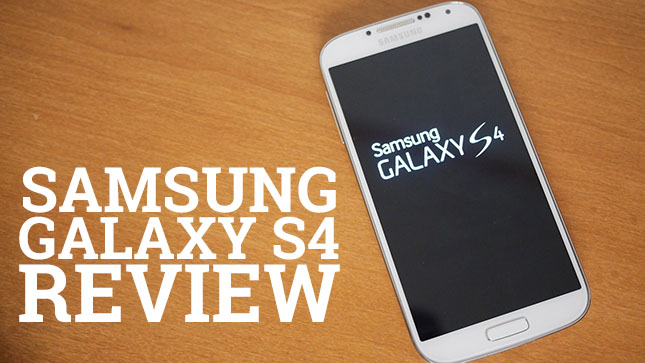
When J.K. Shin, Samsung’s mobile boss, took the stage in the Radio City Music Hall last month, the tech world paused in a second of anticipation. Would the largest smartphone maker in the world deliver again? Would the Galaxy S4 continue the legacy of a series of phones that fundamentally changed the mobile landscape? What we got instead of an answer was a sensory assault that left us enthralled, but also a bit bewildered.
Samsung packed so many new features in the Galaxy S4 that it’s a little difficult to keep track of everything. However, the Korean company took a risky bet when it opted to keep the design of its new flagship in line with last year’s Galaxy S3. And yes, the Galaxy S4 is still made of plastic, at a time when competitors opt for more luxurious materials, like aluminum and glass.
It’s safe to say that the Samsung Galaxy S4 is an evolutionary leap, rather than a radical break with the past, as its predecessors were. But does it live up to the hype? Will consumers be swayed by the richness of software features on the Galaxy S4 or will they long for a new mobile experience, embodied in a more premium design?
Join us for a detailed review of the hardware and software features of the Galaxy S4 or jump to the end of this post for our hands-on video review.
Design: derivative, but also impressive
There’s no getting around it. The Galaxy S4 closely resembles last year’s S3, enough to fool the untrained eye into confusing one device for the other.
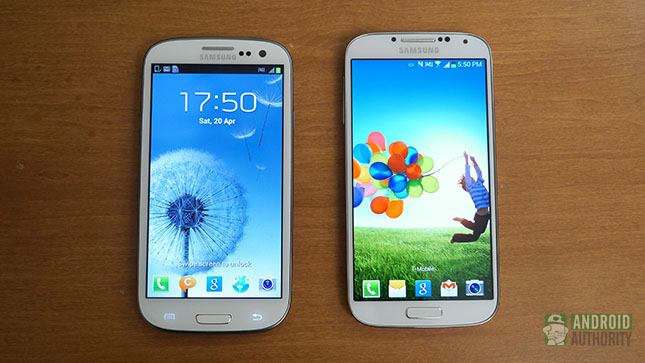
Samsung’s designers slightly tweaked the contour of the Galaxy S4, making it a bit more rectangular, and added a chromed band on the side, which gives the handset a classier look, although it isn’t actually metal.
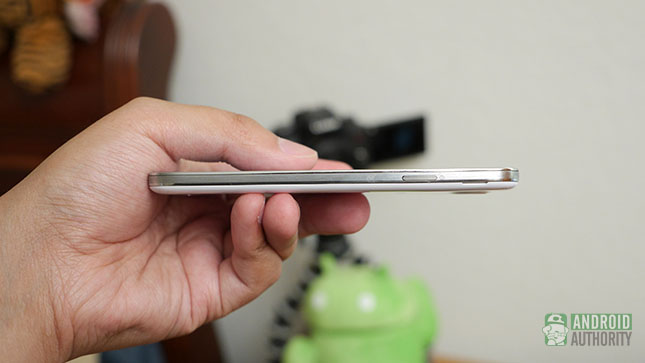
To accommodate the 5-inch display without increasing the bulk of the device, Samsung shrunk the width of the bezels. As a result, the device has a superior screen-to-body ratio when compared to the S3, with an added esthetic benefit granted by the central placement of the home button, which is now similar in shape to that of the Galaxy Note 2.
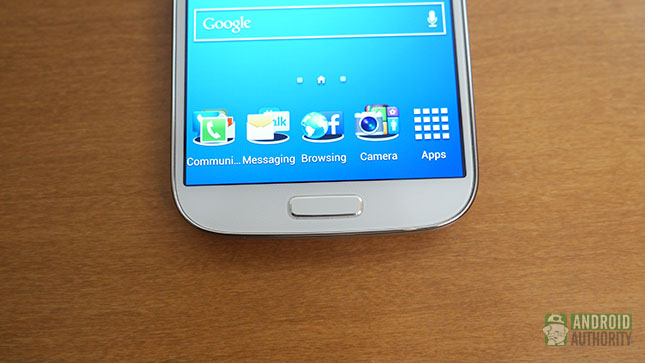
On the back, we have the removable plastic cover that has sparked so many debates in the past. Its detractors say it’s flimsy and that it fails to evoke the premium feeling that one would expect from a cutting-edge flagship. However, the cover allows for a removable battery and microSD card slot, two features that customers consistently look for when buying a device.
Samsung has given up on the glazed finish it used throughout 2012, opting for an elegant mesh pattern instead. We found it intriguing, though it does bear reminiscence to what LG has been using on its recent high-end phones.
The Galaxy S4 is actually lighter and more compact that the S3, an impressive achievement on its own. Moreover, it feels better in the hand, thanks to the flatter sides and its excellent balance. We’d go out on a limb to say that the Galaxy S4 has the best handling of all the 5-inch smartphones we’ve reviewed.
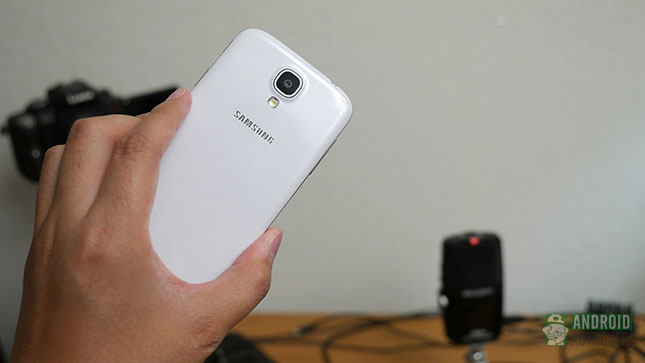
Bottom line, if you enjoyed the design and build of the Galaxy S3, the Galaxy S4 will come off as familiar, but clearly refined. The trade-offs of plastic are hard to notice and the phone feels high-end, without becoming hard to use with just one hand.
AMOLED gorgeousness
If there’s one thing the phones in the Galaxy S line are known for, it’s the deep blacks and vibrant colors of their displays. AMOLED technology has come a long way since the early days, and its incarnation in the screen of the Galaxy S4 compares favorably to almost any other display out there.
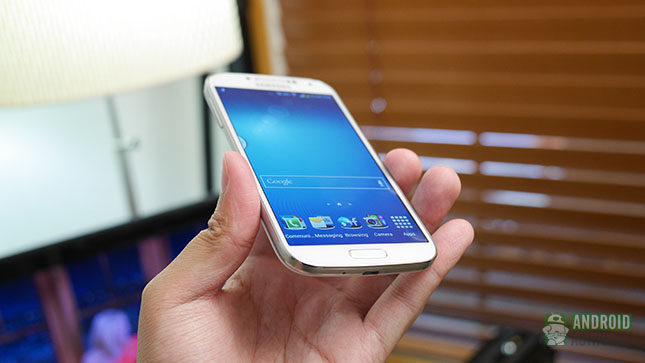
The full HD panel of 441 ppi density is as crisp as they get, and the visibility, regardless of the conditions and viewing angles, is top-notch. The trademark strengths of the AMOLED panel are highlighted by the saturated, cheerful color scheme of the TouchWiz user interface.
Really, the Galaxy S4 sports one of the best displays on any smartphone, hands down.
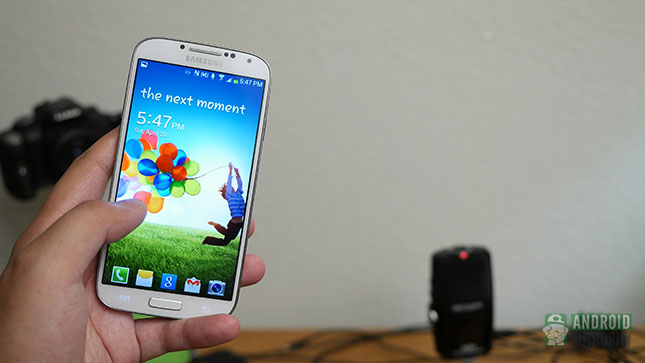
Hardware
Samsung has always excelled at hardware, ever since the days it was one-upping its bigger competitors by packing the very best components into its products. While the new Galaxy S4 isn’t head and shoulders over its competitors (unless you consider the elusive Exynos 5 Octa processor a breakthrough), you won’t find better hardware on the market right now.
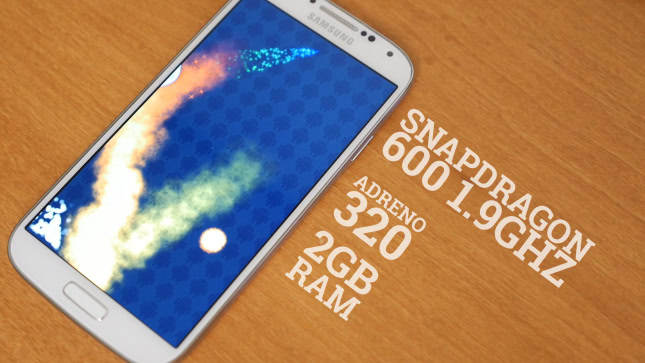
We reviewed the Snapdragon 600 version (coming to the US and most of the other big markets), and, as you’d expect, we found little to nitpick about it. It sails through the benchmarks, hovering around an impressive 25,000 in AnTuTu. Epic Citadel surrenders just as swiftly when faced with the graphics prowess of the Adreno 320 GPU.
It is worth mentioning that the speaker of the Galaxy S4 is pretty much how you would expect. It gets adequately loud and gets the job done, though it would have been even better to have it on the front like HTC’s BoomSound. Can’t win them all, it seems. Still, it is not overly tinny and should satisfy most people looking to share music or YouTube videos.
Sense all the things
Where the Galaxy S4 does shine when compared to the HTCOne, Sony Xperia Z, or the Apple iPhone 5 is the wealth of sensors that Samsung packed inside that 7.9 millimeter thin body. Besides the usual connectivity options we’ve come to expect from any decent Android phone these days, the S4 comes with a barometer, a temperature gauge, an RGB light sensor that calibrates the display according to the environment, an IR blaster (the HTCOne and the Optimus G Pro have that too), an infrared sensor for air gestures, a magnetic sensor for detecting smart covers, and a digital compass.
All this laundry list of sensors is nothing without the software to make sense of all the data, but, for now, let’s just say that the Galaxy S4 is well equipped in this area. More in the software section.
Battery life
The Galaxy S4 draws its power from a 2600 mAh removable battery, which is 500 mAh more than the Galaxy S3. But the S4 has a bigger display and a beefier processor, so the difference in battery life is not that substantial in the end.
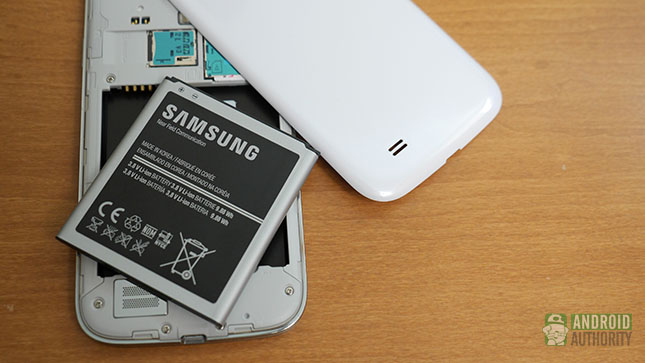
We’ve tested the Galaxy S4’s endurance in a movie streaming test (Netflix on Wi-Fi) that drew the last drop of energy from it in a little under four hours. In a less punishing test (browsing, watching local videos, sync enabled), the Galaxy S4 went through eight hours of continuous operation. Although not as impressive as the Note 2, for instance, we found the battery life of the Galaxy S4 to be satisfying. Plus, the replaceable battery can act as a safety net.
Not another smartphone camera
If, hardware-wise, the two cameras of the Galaxy S4 are not something to write home about, Samsung attempted to make the S4 shine through the software. A host of features gives users some new and potentially compelling ways to use their smartphone cameras.
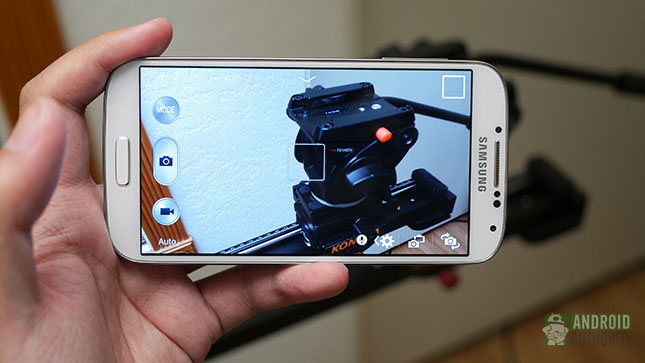
Besides the common options, like HDR and panorama, Samsung packed a Best Face mode that lets you pick the best face from a bunch of burst shots, Animated Photo (useful for making GIFs or cinemagraphs on the fly), and Sound and Shot, which lets you attach a sound clip to your photos.
Similarly intriguing are the Eraser mode and Drama Shot. Eraser mode looks at the background and the subject and tries to erase moving objects that happen to intrude in the picture, to the spite of habitual photobombers.
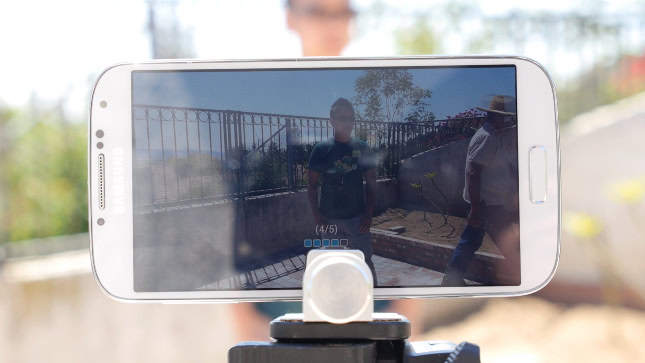

Drama Shot works the other way, sort of. It lets you combine several instances of a moving object in one image. For instance, you could use this feature to photograph the arc of a football your buddies throw.
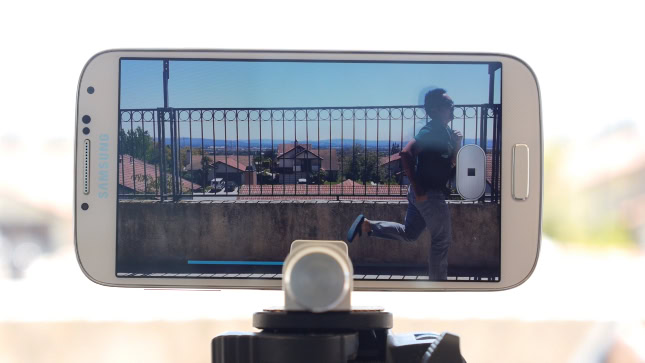

Some of these features might be gimmicky, but those who take the time to check them out could easily find some creative and interesting ways to use them.
From a technical point of view, the quality of the images snapped with the 13MP camera of the Galaxy S4 is excellent. Color saturation and details are well balanced, and overall, we feel that shutterbugs looking for a good camera phone won’t regret buying the Samsung Galaxy S4.
Check out a few Galaxy S4 camera samples (click to enlarge):



Software: features galore
The Samsung Galaxy S4 runs Android 4.2.2 Jelly Bean with the TouchWiz user interface on top. TouchWiz is much vilified in some circles, with critics calling it bloated and gaudy, an assertion that is obviously a matter of personal taste. However, even if you’re not fond of the eye candy-rich interface, you might want to give the Galaxy S4 a spin anyway. That’s because the beautiful 1080p AMOLED display really makes TouchWiz pop in a very eye-pleasing way. Where other UIs struggle to adapt to the high resolutions and pixel densities of modern smartphone screens, TouchWiz feels at home, offering users a pleasant, smooth experience.
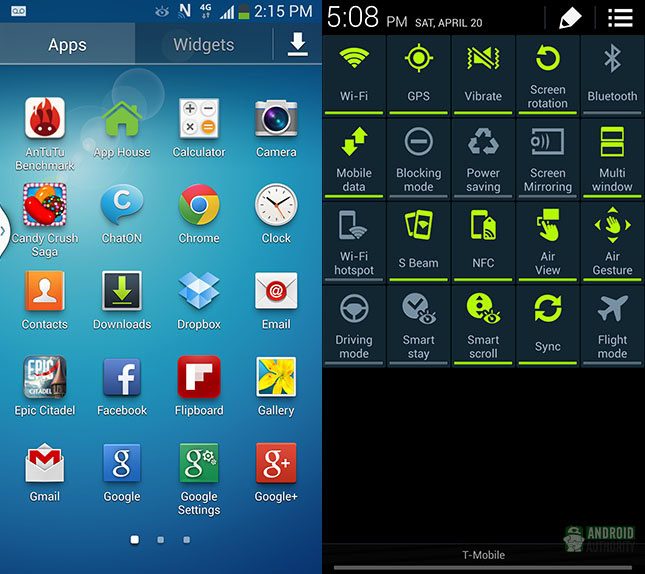
We could spend the next thousand words describing all the features and featurettes that Samsung baked into TouchWiz in its attempt to make the Galaxy S4 the perfect “life companion”. We’ll restrain ourselves though, and tell you about the most important ones, such as the new air gestures, which take advantage of the phone’s motion sensors. Quickly explained, the phone “feels” your fingers as they hover above the screen. It’s an ability we’ve seen before, but Samsung took it to the next level by enabling it in many areas of the interface. Hover your finger over a folder, and you will see a preview of its contents; hover over a gallery, and the first pics will be shown in thumbnails; you can quickly see your last received text without even touching the screen. In short, Samsung transplanted the Air View functionality of the S Pen-equipped Note range to the Galaxy S4.
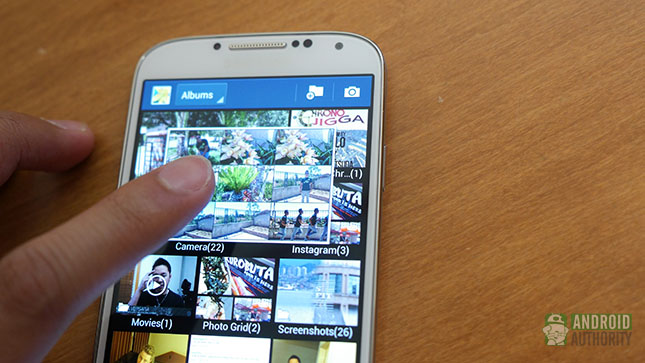
The air gestures can be just as interesting – you can jump to the next music track by flicking your hand over the phone or change the image that you’re viewing. With a wave of the hand, you can invoke the quick info screen that shows your notifications and phone status information. We see many potential use cases for these features, from quickly answering the phone when your hand is wet or dirty to skipping to the next track while jogging.
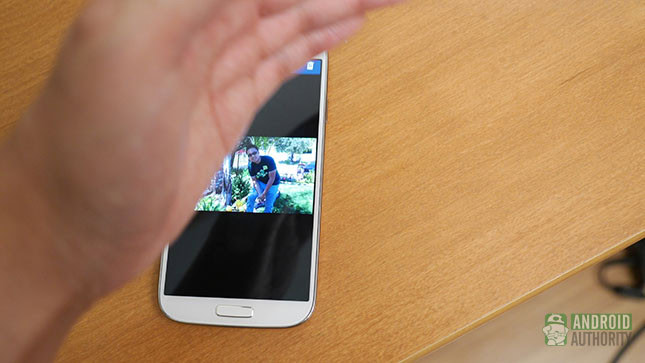
The much touted Smart Pause and Smart Scroll features do exactly what their names suggest. While their usefulness is less clear, some users will surely find them attractive. Other interesting additions are S Translator (though Google Translate does the same thing) and Group Play, which lets users share a track to up to five other phones. While we couldn’t test this last feature for obvious reasons, it does sound like something that some groups of users (okay, teenagers) would appreciate.
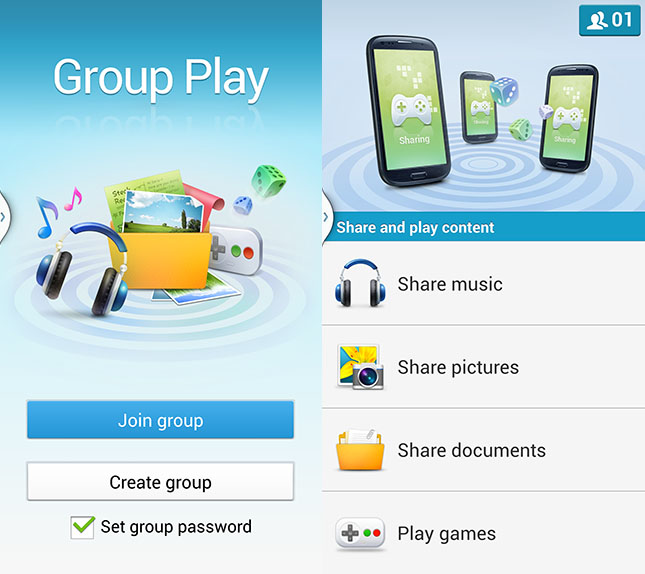
S Health deserves a separate mention. Samsung wants to make S Health the hub of all your diet, sports, and lifestyle activities. For instance, the app lets you calculate calorie intakes or log your weight. With the help of the slew of sensors, S Health becomes a great sports app – it can check the humidity and temperature to tell you about the weather, or count your steps to turn the phone into a pedometer.
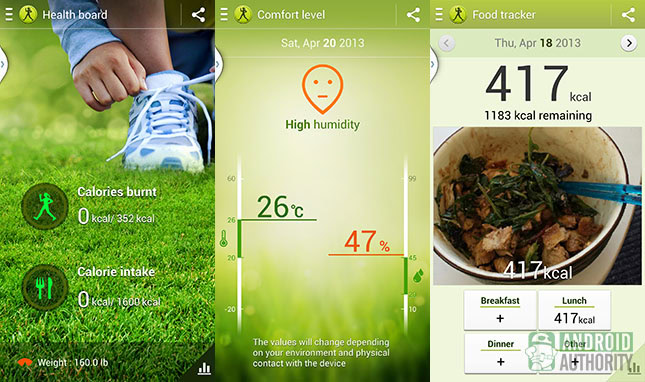
Speaking of which, the Galaxy S4 is said to be compatible with accessories like heart rate monitors, wrist pedometers, and digital scales.
Check out other elements of the Samsung Galaxy S4’s user interface:
[nggallery id=”92″]
Hands-on video
Wrap up and final thoughts
The Samsung Galaxy S4 is coming over the next weeks to all major US carriers, at prices ranging between $150 and $249 on contract, and is expected to be widely available across the world. It’s likely that, if you will be shopping for a new smartphone in the next 18 months, the Galaxy S4 will come up as an option. So, what’s the verdict?
From our time with the Samsung Galaxy S4, we can say that it’s one of the best smartphones of all time, which, while not revolutionary, brings more than enough new stuff to the table to be worth an upgrade. It’s almost better in every way than its predecessor, has top-notch specs, and beats competitors when it comes to software and hardware features.
Samsung worked hard to perfect its product design (hardware and software) and it succeeded in most part. The caveats are the plastic build and the somehow over-the-top TouchWiz user interface, but if you are okay with that, the Galaxy S4 is a smartphone that we can fully recommend.
Bogdan Petrovan contributed to this review.